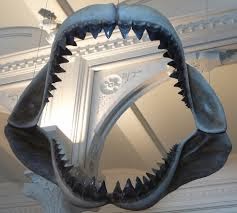SHARKS OF THE PAST
Welcome to sharks of the past. On this page we will tell you about sharks that have died out. Are you ready to plunge into the deep, watery world of the past? Read on...
THE MEGLADON
The mighty megladon (mentioned in the great white shark post) ruled the seas until 1,500,000 years ago. It grew up to 18 metres long and fed on whales, porpoises and other sharks.
Scientists know very little about the megladon as sharks don't make good fossils but they have a rough idea what a megladon would look like by using the great white as a template and can estimate it's size by the size of it's (fossilised) jaws. |
| The size of a megalodon compared to today's sharks. |
 |
| The jaw of a megalodon, displayed in the American museum of Natural History. |
THE WHORL-TOOTH
These sharks supposedly ate fish and crustaceans, but with no fossil remains aside from the teeth - seeing as all sharks are made of cartilage which is eaten away quite quickly be time - there is no way to prove this. The teeth and few legacies of these sharks have been discovered in China, Western Australia, the U.S and Canada.
 |
| An artist's representation of a whorl-tooth shark. |
No comments:
Post a Comment